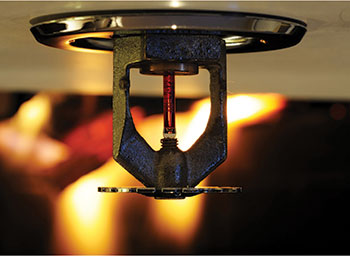 |
|
Photo by Justin Krall/Shutterstock Fire safety once again will be one of the major compliance issues in health care facilities. |
The physical environment of care compliance hot topics for 2016 spans a wide variety of issues, from the most commonly cited areas to recent or anticipated changes in authority having jurisdiction (AHJ) requirements.
Many organizations consider the hottest physical environment of care topics to be the ones most likely to cause adverse findings during accreditation surveys. Others may look at the issues more holistically, recognizing that accreditation survey adverse findings point to areas where improvement is appropriate because it also is the right thing to do.
The most problematic areas often involve human behavior, whether leaving a door open to a pressure-controlled or humidity-controlled area too long or parking a wheeled cart in front of a fire extinguisher or an oxygen-zone valve.
Mitigating risks
The Joint Commission’s publications regularly report and offer compliance recommendations on the Joint Commission’s Top 10 most frequently cited standards. Those standards historically include strong representation from the Joint Commission’s Environment of Care (EC) and Life Safety (LS) chapters, both of which set rules governing the management of the physical environment. Other accreditation organizations have shared similar information in the past.
You may also like |
| Continuous health facility compliance |
| Staying on top of fire safety codes |
| New Joint Commission imaging regulation |
| |
Many of the hot topics involve managing and mitigating risks to health care facility patients, staff and visitors. Some risks are related to general safety, such as electrical and other miscellaneous hazards, unsecured oxygen cylinders and ligature risks. They also include such utility risks as airborne and waterborne contaminants or utility system malfunctions. Lastly, they include life- and fire-safety risks such as degraded means of egress, fire safety building features, fire barriers, smoke barriers, fire-rated doors or problems with fire safety equipment. Sometimes, individual citations may not make much sense to the surveyed health care organization. In those cases, organizations should be prepared to discuss the basis for the citations so they understand the actual requirement.
The usually high percentage of citations related to fire safety equipment inspection, testing and maintenance (ITM) often appears to be related to the sheer volume of work required to manage inventory changes along with all of the required ITM records.
The Joint Commission and American Society for Healthcare Engineering (ASHE) have partnered to provide compliance resources for the most problematic Joint Commission physical environment standards. The Joint Commission Physical Environment Portal and ASHE’s Focus on Compliance initiative are complementary efforts with much of the posted resource information available to the public. Early postings provided resources addressing utility system risk management issues and means of egress in some detail from the different perspectives of the AHJ and the membership organization. Future postings will include the built environment, fire protection, three categories of life safety requirements, and hazardous materials and waste management issues.
A hot EC topic related to HVAC system design and subsequent operation occurs when AHJ enforcement and interpretations of similar codes and standards requirements conflict. A major example was discussed in a recent joint guidance statement issued by six national organizations that addressed confusion and conflicts between standards to be applied during design and renovation of a facility, and other standards to be used as daily operational guidelines.
That joint guidance statement emphasized that design requirements — like the American National Standards Institute/American Society of Heating, Refrigerating, and Air-Conditioning Engineers (ASHRAE)/ASHE Standard 170-2013 and the Facility Guidelines Institute’s 2014 Guidelines for Design and Construction of Hospitals and Outpatient Facilities — are not the same as clinical practice recommendations — such as the Association for the Advancement of Medical Instrumentation ST79 and the Association of periOperative Registered Nurses Guideline for a Safe Environment of Care, Part 2.
During 2015, the Occupational Safety and Health Administration (OSHA) announced that it would be increasing enforcement within hospitals. Stating, “The rate of work-related injuries and illnesses at U.S. hospitals is nearly twice as high as the overall rate for private industry,” OSHA officials asked their inspectors to focus on five key hazards at hospitals and other inpatient care sites including nursing homes.
OSHA stated that the five hazards include musculoskeletal disorders due to patient handling; bloodborne pathogens; workplace violence; tuberculosis; and slips, trips and falls. OSHA also stated that it has asked inspectors to check for other hazards, including exposure to multidrug-resistant organisms and exposure to hazardous chemicals like sanitizers, disinfectants, anesthetic gases and hazardous drugs. Many of these issues were already on hospital “hot topic” lists, but OSHA’s notice of increased enforcement actions might cause even more EC management focus.
Changes of concern
Codes and standards changes also concern many hospitals. As the health care facilities field readies itself for the anticipated Centers for Medicare & Medicaid Services (CMS) adoption of the 2012 Life Safety Code (NFPA 101) and 2012 Health Care Facilities Code (NFPA 99), there are concerns about the dozens of other substantially newer National Fire Protection Association standards with mandatory references from those two code editions that also would be enforced.
Because compliance subtleties are often in the nuanced details of newer codes and standards language, health care facility managers are rightly concerned about the changes and how their work could be affected. This is another one of those areas in which focused education may be appropriate.
Additionally, emergency management continues to be an area requiring focus. Whether the source of increased focus is an expansion of AHJ emergency management requirements or breaking news anywhere in the world, it is important for hospital emergency managers to be aware of new needs and introduce them into existing processes. The CMS notice of its intent to expand emergency management requirements caused substantial public comment.
Subsequent to the November 2015 terrorist attacks in Paris, for example, an alert from the American Hospital Association disseminated a message from the Department of Homeland Security (DHS) calling for even more enhanced vigilance by health care organizations. DHS asked members of the health care and public health community to review with their staff members the need for situational awareness of behaviors, objects and activities that depart from the norm, are out of place for the area, prompt suspicion, or otherwise raise safety or security concerns.
As the world changes and AHJs impose changed requirements, it may be necessary to update previous risk assessments to properly reprioritize previously identified risks and factor in newly assessed risks.
The annual ECRI Top 10 list of health technology hazards is usually a good indicator of changes within the realm of health technology, which includes the EC area of medical equipment. The 2016 ECRI Top 10 list includes such problem areas as inadequate cleaning of flexible endoscopes, consequences of missed clinical alarms, inadequate telemetry patient surveillance, and inadequate training on operating room technologies, along with six other problematic health technology areas.
ASHRAE 188-2015 is another example of changes affecting hospitals and other health care organizations. This standard provides an approach intended to reduce the risk of adverse consequences from a Legionella outbreak. This is one of those areas where focused education may be appropriate.
Surveyor observations
The world of regulatory compliance involves regular immersion within the details of the physical environment. Attention only to the high levels of compliance rarely suffices.
Within the area of life safety code compliance, details such as door gaps, inadequate door closing or latching and painted-over UL labels can bring adverse survey findings. Penetrations in fire barriers or smoke barriers can be missed by all except eagle-eyed surveyors.
One glance down a hospital corridor will tell a surveyor if something has been parked in front of a fire extinguisher, an electrical panelboard or a medical gas zone valve. Another glance by a surveyor’s fresh eyes either down a corridor or within a suite can identify issues with ceiling tiles, sprinkler escutcheons or stored materials within the sprinkler’s 18-inch exclusion zone.
As mentioned, some hot topics are behavior-based. Where certain equipment is permitted to be located within corridors because it is always considered to be in use, other equipment is considered stored if it is plugged into an outlet or parked in the same spot for a stipulated duration. Those rules are reasonably well-understood within most hospital clinical units. This is as far as many corridor clutter discussions often go.
Besides the issue of corridor clutter, there are some items that should never have anything directly in front of them for any duration, according to most AHJs, such as medical gas zone valves, fire extinguishers, electrical panelboards, fire alarm manual pull stations and eyewash stations. One way to think of materials or equipment blocking access to those items could be that they might be the EC or LS equivalents of “never events.” The never-event concept is well-known to hospital clinical personnel.
A surveyor’s fresh eyes rarely miss issues during a compliance records review session. It is often easy to spot outliers within compliance records simply because the outliers are different from the information before and after them. And surveyors also know where other organizations have struggled, so they usually know where to look to see if the organization being surveyed is struggling as well.
Areas that have been hot buttons for years continue to be problematic compliance areas for many organizations. The requirement to have an Interim Life Safety Measure (ILSM for Joint Commission-accredited organizations) or Alternate Life Safety Measure (ALSM for organizations accredited by others) assessment of uncorrected life safety code deficiencies, along with the appropriate ILSM/ALSM compensatory measures, continues to be low-hanging fruit for adverse survey findings. The sheer number of deficiencies that occur over time due to physical wear or equipment failure makes this issue a hard one for many organizations to manage successfully.
Other document-review or compliance record-review areas providing low-hanging fruit for surveyors include those related to ITM for emergency power supply systems. From the required weekly inspections to the required monthly and annual testing, and then to the maintenance that must comply with manufacturer recommendations as well as the other NFPA 110 requirements, this set of compliance requirements has been problematic for years despite there being little question about the details of the specific requirements.
A 2014 change by CMS also has caused EC compliance issues for many organizations that are not yet fully compliant — the expanded CMS requirements for equipment inventories and ITM requirements, along with the need to have a documented risk-based alternate equipment maintenance program if the organization intends to deviate from following manufacturer recommendations where permitted.
Pressing regulations
Working in one of the most closely regulated fields in the United States, health care facilities professionals have a daunting list of codes and standards about which they must be knowledgeable.
The areas described provide a good sense of some of the most pressing regulations as facility managers start the new year.
David L. Stymiest, PE, CHFM, CHSP, FASHE, is a senior consultant at Smith Seckman Reid Inc., specializing in facilities engineering and regulatory compliance. He can be reached at DStymiest@SSR-Inc.com.





